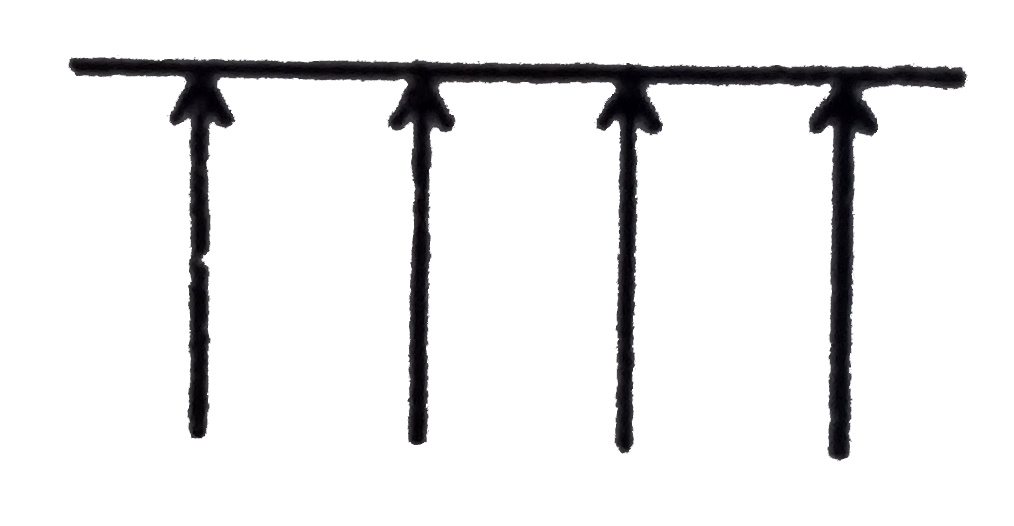A narrow beam of monochromatic light of wavelength emitted from a source of power P is propogating in the positive x-direction. After being reflected from a perfectly reflecting plane mirror of area vector , the beam falls on a metal plate of surface area A[ is along outward normal at mirror]. the force exerted by light beam on the mirror is and is change in momentum of each photon then [cis speed of light in vacuum]
The correct Answer is:A
To solve the problem step by step, we will analyze the situation involving the monochromatic light beam, its interaction with the mirror, and the resulting force and momentum change.
Step 1: Understanding the Problem
We have a monochromatic light beam of wavelength λ emitted from a source with power P. The beam travels in the positive x-direction and reflects off a perfectly reflecting mirror. The area vector of the mirror is given as →A=A(−^i−^j).
Step 2: Momentum of a Photon
According to the de Broglie hypothesis, the momentum p of a single photon is given by:
p=hλ
where h is Planck's constant.
Step 3: Initial and Final Momentum of the Photon
- The initial momentum of the photon traveling in the positive x-direction is:
→pinitial=hλ^i
- Upon reflection, the photon will change direction but maintain the same magnitude of momentum. The final momentum will be:
→pfinal=−hλ^j
Step 4: Change in Momentum of a Single Photon
The change in momentum Δ→p for a single photon is calculated as:
Δ→p=→pfinal−→pinitial=−hλ^j−hλ^i=−hλ(^i+^j)
Step 5: Total Change in Momentum
If n is the total number of photons incident on the mirror in a time interval Δt, the total change in momentum Δ→P is:
Δ→P=nΔ→p=n(−hλ(^i+^j))
Step 6: Number of Photons Incident
The energy emitted in time Δt is:
E=PΔt
The energy of a single photon is:
Ephoton=hcλ
Thus, the total number of photons n can be expressed as:
n=PΔthcλ=PλΔthc
Step 7: Force Exerted by the Light Beam
The force →F exerted on the mirror can be calculated using the rate of change of momentum:
→F=Δ→PΔt=nΔ→pΔt
Substituting for n and Δ→p:
→F=PλΔthc(−hλ(^i+^j))1Δt
This simplifies to:
→F=Pc(−^i−^j)
Final Result
Thus, the force exerted by the light beam on the mirror is:
→F=Pc(−^i−^j)
And the change in momentum of each photon is:
Δ→p=−hλ(^i+^j)
We have a monochromatic light beam of wavelength λ emitted from a source with power P. The beam travels in the positive x-direction and reflects off a perfectly reflecting mirror. The area vector of the mirror is given as →A=A(−^i−^j).
According to the de Broglie hypothesis, the momentum p of a single photon is given by:
p=hλ
where h is Planck's constant.
- The initial momentum of the photon traveling in the positive x-direction is:
→pinitial=hλ^i
- Upon reflection, the photon will change direction but maintain the same magnitude of momentum. The final momentum will be:
→pfinal=−hλ^j
The change in momentum Δ→p for a single photon is calculated as:
Δ→p=→pfinal−→pinitial=−hλ^j−hλ^i=−hλ(^i+^j)
If n is the total number of photons incident on the mirror in a time interval Δt, the total change in momentum Δ→P is:
Δ→P=nΔ→p=n(−hλ(^i+^j))
The energy emitted in time Δt is:
E=PΔt
The energy of a single photon is:
Ephoton=hcλ
Thus, the total number of photons n can be expressed as:
n=PΔthcλ=PλΔthc
The force →F exerted on the mirror can be calculated using the rate of change of momentum:
→F=Δ→PΔt=nΔ→pΔt
Substituting for n and Δ→p:
→F=PλΔthc(−hλ(^i+^j))1Δt
This simplifies to:
→F=Pc(−^i−^j)
Thus, the force exerted by the light beam on the mirror is:
→F=Pc(−^i−^j)
And the change in momentum of each photon is:
Δ→p=−hλ(^i+^j)
Similar Questions
Knowledge Check
- Question 1 - Select One
A ray of light after reflection from a mirror is known as
Areflected rayBnormalCincident rayDrefracted ray
A perfectly reflecting solid hemisphere of radius R is placed in the path of a parallel beam of light of large aperture. If the beam carrries an intensity l, find the force exerted by the beam on the hemisphere.
View SolutionA monochromatic beam of light of wavelength λ and frequency v goes from vacum to a medium of refractive index n. How do the wavelength and frequency of light change ?
View SolutionA beam of monochromatic light of wavelength λ falls normally on a diffraction grating of line spacing d. If θ is the angle between the second-order diffracted beam and the direction of the incident light, what is the value of sinθ ?
View SolutionA beam of monochromatic light of wavelength λ falls normally on a diffraction grating of line spacing d. If θ is the angle between the second-order diffracted beam and the direction of the incident light, what is the value of sinθ ?
View SolutionA perfectly reflecting mirror has an area of 1cm2 Light enery is allowed to fall on it 1 h at the rate of 10Wcm2. The force that acts on the mirror is
View SolutionA plate of mass 10gm is in equillibrium in air due to the force exterted by light beam on plate. Calculate powder of beam. Assume plates is perfectly absorbing.
 View Solution
View SolutionA beam of monochromatic light is refracted from vacuum into a medium of refractive index 1.5 The wavelength of refracted light will be
View Solution

